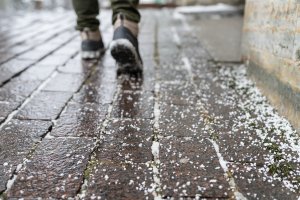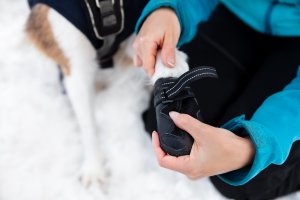Salty roads, salty waterways: reducing salt use in winter
January 31, 2024
By Erin Parker, Interpretive Services Supervisor
Michigan’s salty season has arrived with ice, snow, and a challenging combination of bitterly cold, and even warm, wet temperatures making our roadways and pedestrian pathways slick and potentially dangerous. Along with plowing and shoveling, salt is one of the tools to manage these slippery conditions. Motorists, cyclists, and pedestrians all need traction for safety and salt is one of the least expensive ways to provide safer surfaces. But salt has a lot of drawbacks, too.

Salty dilemmas
Did you know that a single teaspoon of road salt can negatively impact five gallons of freshwater and that the impact is permanent? Road salt is typically sodium chloride…just like table salt but with many more impurities potentially present. Salt applied during cold periods eventually washes off and enters streams and culverts. The salty liquid runoff from roads harms the soil and can even enter our drinking water systems. Roads, bridges, and other infrastructure can be corroded by contact with salt. Once salt enters our waterways, it can be virtually impossible to remove. This can harm aquatic insects, plants, and fish.
The Great Lakes watershed is a freshwater ecosystem that would typically have extremely low chloride levels of 1 milligram of chloride per liter of water. Road salt usage isn’t just making small, local waterways saltier- it’s actually increasing the overall saltiness of these huge freshwater lakes! Lake Michigan, for example, is now closer to 15 milligrams per liter of chloride.
Are there ways to reduce or replace salt use that provide the same or similar levels of safety?
Michigan Department of Transportation is reducing salt use, like many other states, by combining it with an extract made from beets. The combination works in colder temperatures than traditional salt, and because of that is more environmentally-friendly. Because beets are a common crop for sugar production, they are also readily available and renewable. The salt-beet juice mixture is a applied as a brine instead of the solid, pellet form in which road salt is typically applied.

Winter’s slippery conditions aren’t improved solely by melting the ice and snow. Application of sand can improve traction and even slows refreezing of ice. Sand will also eventually enter streams and waterways as it washes off during periods of snowmelt and rain, so sand should also be applied only as needed.
Options for homeowners
For those of us tasked only with keeping our own driveways clear, we can focus on snow removal first, determine which areas really require de-icing, and then lightly apply a product to reduce the ice. Remember that any salt applied will end up on soil and plants, and can damage and even kill trees and gardens through time!
Another option that is easier to accomplish in smaller areas is to break up ice before applying salt.
Recommendations for salt application is probably much less than the typical homeowner is applying. More salt doesn’t mean faster melting so sticking with about 1 cup for 250 square feet (imagine an area the size of two parking spaces) if you are using rock salt. Formulations made with calcium chloride, another home deicing product, can be used even more sparingly. Careful and focused application also means less risk of salts burning your plants, lawn, and garden.
Finally, any salt left on surfaces once they’re dry, can be swept up and reused- meaning less salt entering the environment and saving a little money, too.
Pets and winter deicing products
Other environmentally-and-pet friendly de-icers exists, typically formulated without salts. Road salt is not the same thing as table salt and can contain heavy metals or contaminants. It is also considered toxic to dogs and can cause poisoning systems. Even if the salt isn’t ingested, it can cause irritation to pet paws if they encounter it on roads and sidewalks.

One more warning, the components of windshield wiper fluid that get drivers through the messy winter season contain antifreeze. This can have a sweet taste that is appealing to pets and wildlife, so pet owners and wildlife watchers should make sure to thoroughly clean up any spills or leaks of products containing antifreeze and make sure that containers are completely closed and stored where animals cannot access them.
We all need safe roads and want to be able to access the outdoors via pedestrian paths, even during the winter months. Finding a balance between salt application for safety and reducing the future harm to aquatic environments is something we can all do.
Interested in reading more?
- Ask the Expert: Is road salt making the Great Lakes saltier?
- Can’t beet Michigan roads this upcoming brutal winter
- Is Ice-melting salt bad for dogs? How to keep paws safe in snowy weather
